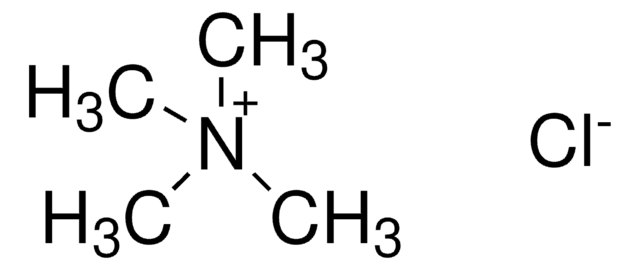T3038
Trizma® hydrochloride solution
1 M, BioReagent, for molecular biology
Sinonimo/i:
Tris hydrochloride solution
About This Item
Prodotti consigliati
Grado
for molecular biology
for molecular biology
Livello qualitativo
Sterilità
0.2 μm filtered
Nome Commerciale
BioReagent
Forma fisica
solution
Concentrazione
1 M
Impurezze
DNase, RNase, NICKase and protease, none detected
pH
8.0
applicazioni
agriculture
Stringa SMILE
Cl.NC(CO)(CO)CO
InChI
1S/C4H11NO3.ClH/c5-4(1-6,2-7)3-8;/h6-8H,1-3,5H2;1H
QKNYBSVHEMOAJP-UHFFFAOYSA-N
Cerchi prodotti simili? Visita Guida al confronto tra prodotti
Descrizione generale
Applicazioni
- As buffer for the 2-D electrophoresis of rat fibroblast cell.
- As buffer for the rapid isolation of high molecular weight plant DNA (50,000 base pairs or more in length).
- Selective immunoprecipitation of biotin-labeled DNA with antibiotin IgG and Staphylococcus sp.
For precise applications, use a carefully calibrated pH meter with a glass/calomel combination electrode.
Altre note
Note legali
Codice della classe di stoccaggio
10 - Combustible liquids
Classe di pericolosità dell'acqua (WGK)
WGK 2
Punto d’infiammabilità (°F)
Not applicable
Punto d’infiammabilità (°C)
Not applicable
Dispositivi di protezione individuale
Eyeshields, Gloves, type ABEK (EN14387) respirator filter
Certificati d'analisi (COA)
Cerca il Certificati d'analisi (COA) digitando il numero di lotto/batch corrispondente. I numeri di lotto o di batch sono stampati sull'etichetta dei prodotti dopo la parola ‘Lotto’ o ‘Batch’.
Possiedi già questo prodotto?
I documenti relativi ai prodotti acquistati recentemente sono disponibili nell’Archivio dei documenti.
I clienti hanno visto anche
Il team dei nostri ricercatori vanta grande esperienza in tutte le aree della ricerca quali Life Science, scienza dei materiali, sintesi chimica, cromatografia, discipline analitiche, ecc..
Contatta l'Assistenza Tecnica.










